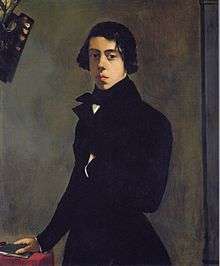Self-portrait (Chassériau)
 | |
| Artist | Théodore Chassériau |
|---|---|
| Year | 1835 |
| Medium | oil on canvas |
| Dimensions | 99 cm × 82 cm (39 in × 32 in) |
| Location | Musée du Louvre, Paris |
Self-Portrait, or Portrait of the Artist in a Redingote, is an 1835 oil-on-canvas painting by French romantic artist Théodore Chassériau, which was painted when the artist was 16. It is currently housed at the Musée du Louvre.
One of the few self-portraits Chassériau painted, Portrait of the Artist in a Redingote shows him standing and facing left, one hand concealed within his black jacket, a small book held within his other hand, at rest upon a red tablecloth. In the background is a gray-green wall, upon which hangs a palette in the upper left corner. The painter's pose is elegant, and his gaze has been described as "astonishingly young, and at the same time, weary".[1]
Although the painting has been compared to classical and contemporary prototypes—portraits by Raphael, Bronzino, Titian, and Ingres have been cited as inspirations—the painting is consistent with a series of portraits of family members painted by Chassériau in his youth.[1] The portrait is a frank portrayal of Chassériau's unattractive features, much commented upon during his life: Alice Ozy, later his mistress, referred to him as "the monkey".[1] By comparison, a self-portrait of 1838, also in the Louvre, appears more idealized.[1]